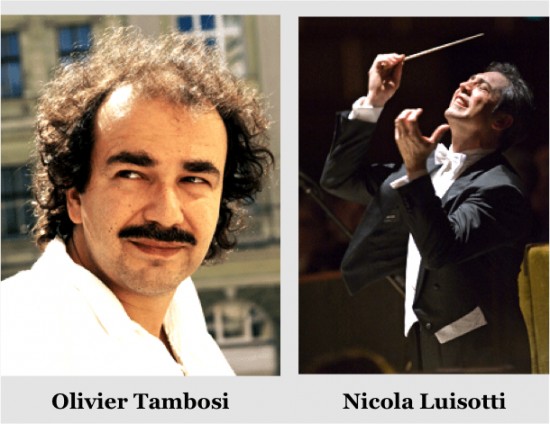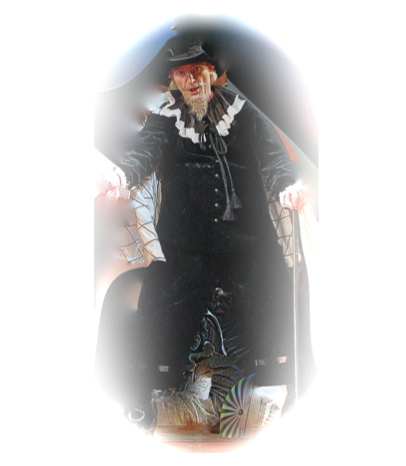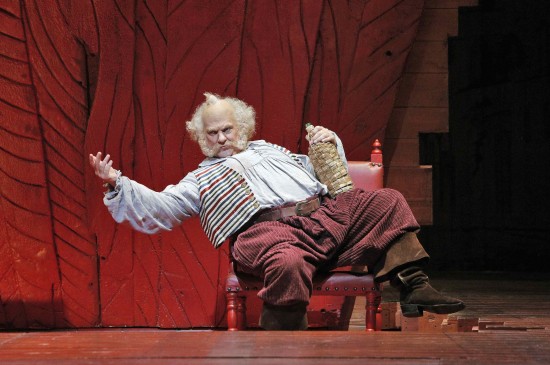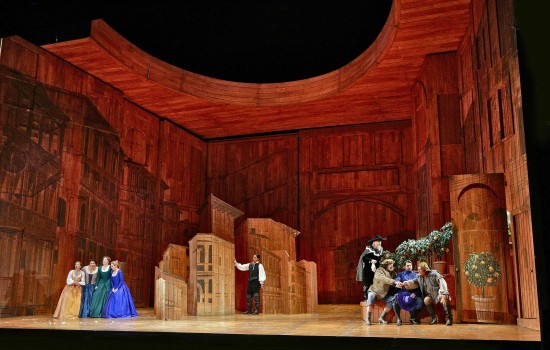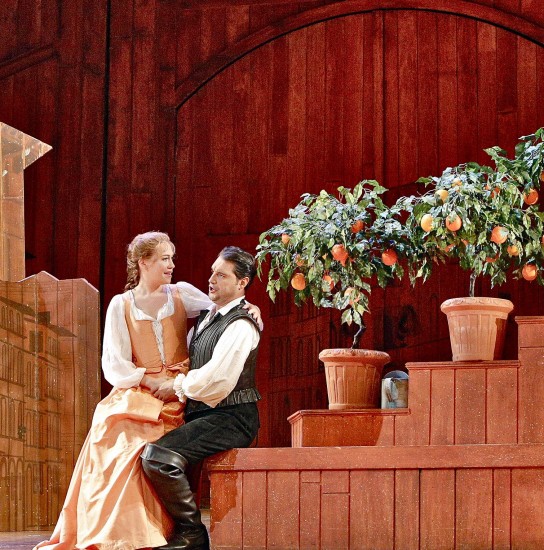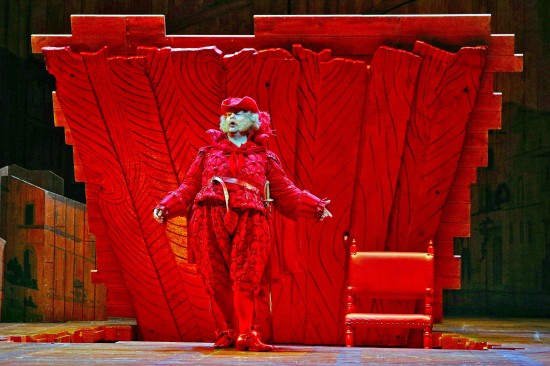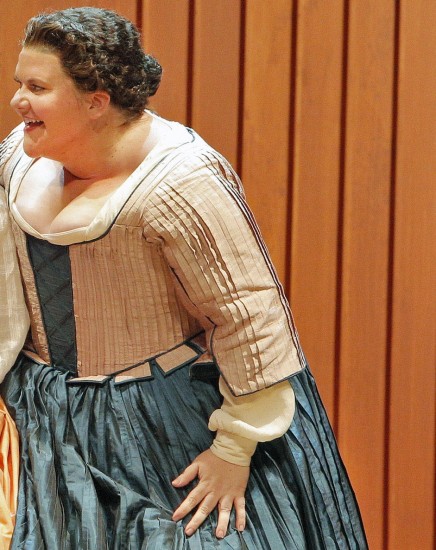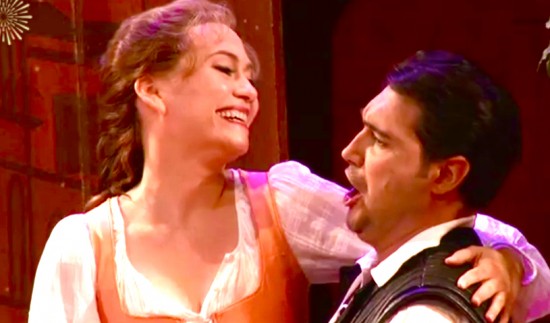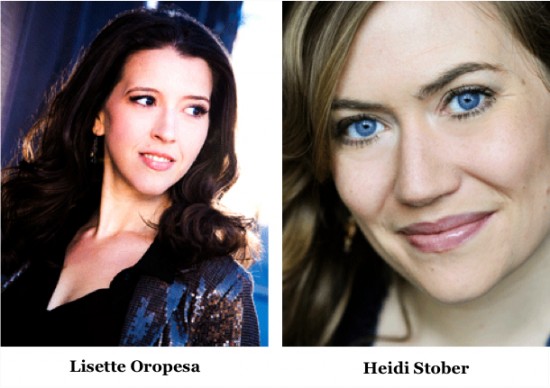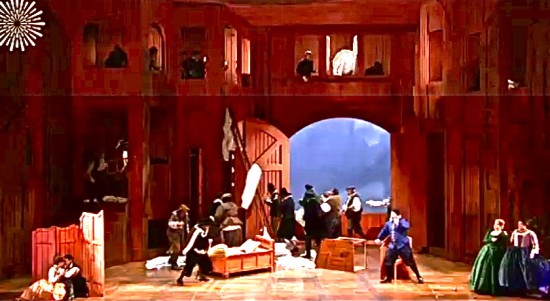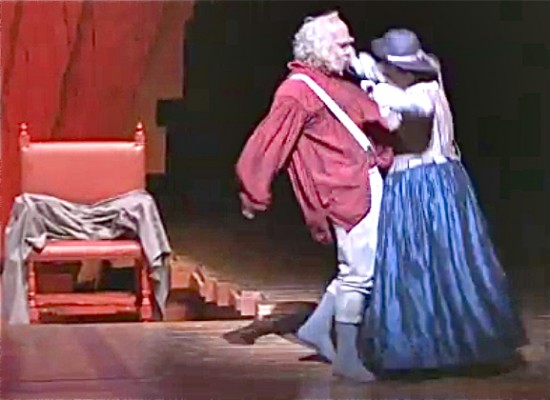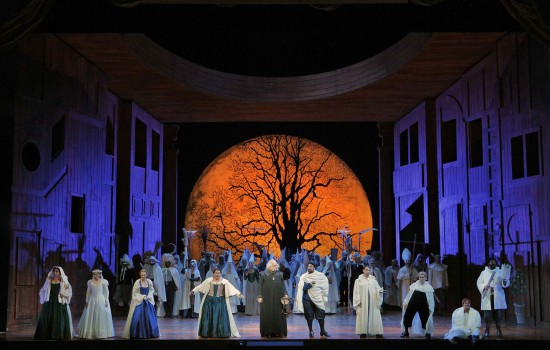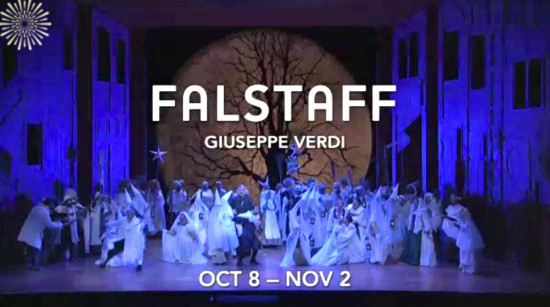When you start with a plot by Shakespeare, music by Verdi, libretto by Boito, an orchestra conducted by Nicola Luisotti, and title role sung by Bryn Terfel, it is not surprising that the result is a wonderful evening of entertainment.
Director Oliver Tambosi has really brought out the emotional scope of the opera. The comedy is broad – almost slapstick at times; the lovemaking is tender; the pathos is touching but not maudlin; the ending is joyous. The action is fast-paced and Maestro Luisotti makes sure the orchestra keeps pace. Indeed, action and music are so precisely fitted to each other that it would be false to say that either one leads the other.
The broad tone of the comedy is set by a sight gag before the first note is sung. The curtain is up when we enter the theatre, and we see the cavernous bare stage. It’s still there when the orchestra starts the dramatic overture. Imagine the scene shown in the lead picture above but with no people, no props, and the giant trap door lowered to show only unbroken stage floor.
The dramatic overture starts, and before it is finished, a shadowy figure limps on stage, obviously irate at finding no one else there. He pulls a chair near center stage, inadvertently placing it half on the trap door – which then starts to open, sending Dr. Caius (Joel Sorensen) and the chair sprawling.
The trapdoor swings open pulling up Falstaff (Bryn Terfel), complete with bottle of sack,
Pistola (Andrea Silvestrelli) and Bardolfo (Greg Fedderly) come on stage, and we are under way with Act I, Scene 1.
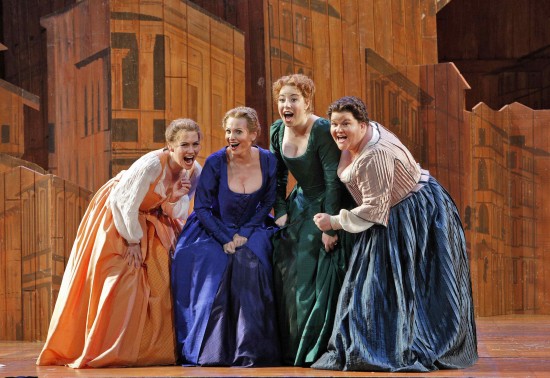
Nannetta (Heidi Stober), Alice Ford (Ainhoa Arteta), Meg Page (Renee Rapier), and Dame Quickly (Meredith Arwady) are amused by Falstaff’s love letters
The four women are introduced in Scene 2. Wives Alice Ford (Ainhoa Arteta) and Meg Page (Renee Rapier) receive Sir John’s identical love letters and immediately share them with their neighbor Dame Quickly (Meredith Arwady) and with Alice’s daughter Nannetta (Heidi Stober). Later they conspire to humiliate the Fat Knight.
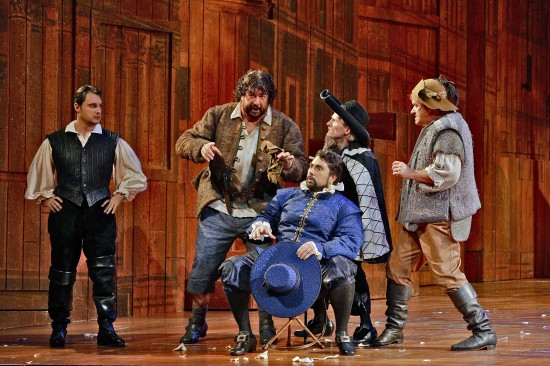
Fenton (Francesco Demuro) listens while Bardolfo, Ford (Fabio Capitanucci), Dr. Caius, and Pistola plot revenge
Later in the scene we meet the five men – Fenton (Francesco Demuro), Bardolfo, Ford (Fabio Capitanucci), Dr. Caius, and Pistola – who, together with Falstaff and the women constitute the singing soloists of the opera.
The blocking in this scene is worthy of ballet. The two quartets circulate in and out of the action spotlight singing a group of lines of the libretto, and moving – mostly running – with little dance-like steps.
Fenton may sing with the men, may move independently, or may cull Nannetta from the women for a bit of smooching. The movement, the singing, the intricate melodies and harmonies, all precisely fitted together like a four-dimensional jigsaw – this whole scene is a gem within a gem.
Falstaff (the character) dominates Falstaff (the opera), and Bryn Terfel (the bass) IS Falstaff (the character). His voice is fantastic. Early in Act I Scene 1 it would be clear from his voice alone that this guy is a leader. The proceedings will center on him. But it is a benevolent domination based entirely on ability. Rather than intimidate the other singers, he inspires them to their own excellences.
Falstaff is a complex character, and Terfel captures all of that complexity in both his singing and his acting. In Act I he pontificates and is domineering. In Act II he is at various times greedy, self-satisfied (a delusion) in his lovemaking, cowardly, and pitiable. In Act III Scene 1 he is perfect at conveying his misery over his humiliation and dunking – his voice so ringing and confident before now reduced to pianissimo but clearly audible. And at the end of the final scene he is exuberant in his happiness.
Just as Terrel’s bass voice anchors the male singers, the rich contralto of Meredith Arwady anchors the females. Her voice is excellent in its entire range, but it is unbelievable in the low registers. It’s worth the price of a ticket just to hear her sing “Reverenza” to Falstaff early in Act II. Later in the act she recounts her visit with the knight to the other women and gets her voice even deeper when quoting him. Her acting is on a par with her singing, and she moves about the stage with surprising grace and agility.
Tenor Francesco Demuro and Soprano Lisette Oropesa were a most endearing couple as the young lovers Fenton and Nannetta. And yes, I said Lisette Oropesa, and yes, the picture title says Heidi Stober – and they are both correct!
A press release on October 14 explains it all: Soprano Lisette Oropesa will sing the role of Nannetta in the Tuesday, October 15 performance of Verdi’s Falstaff. Ms Oropesa replaces Heidi Stober, who is ill, for this performance. Ms. Stober is expected to resume the role for the remaining performances of Falstaff beginning October 20.
I had fallen in love with Heidi three years ago after seeing and hearing her perky portrayal of Susannah in The Marriage of Figaro, and had been looking forward to watching her again. Judging by the video clips and photos, my love would have been rekindled. Not that I have any complaints, mind you. Lisette’s bio is, if anything, even more impressive than Heidi’s, and her performance Tuesday was thoroughly satisfactory as to both voice and actions. SFOpera was indeed fortunate to get her for a one-night stand!
All through Act II Scene 2, the opera has been building to its comical climax. Falstaff is hidden in the giant laundry basket, Fenton and Nannetta are smooching behind the screen, Alice has disappeared, Meg and Quickly are standing, observing, and trying to squelch their mirth. Ford and his posse are searching frantically for the presumed lovers Falstaff and Alice. What with one thing and another there are lots of white sheets strewn about the house – and each one is regarded as a potential cover for the couple. A searcher yanks a sheet up and flings it in the air with an incipient “Aha!” only to discover nothing was there. It lands wherever for another searcher to repeat the process, not only in the hall, but sheets are being flung from and to all the second story windows. All with frenetic music to match. It was a scene worthy of the Marx Brothers and I couldn’t resist laughing out loud.
One more comic scene in Act III Scene 1. With the aid of some mulled wine Falstaff has recovered from his earlier misery, but is still furious with Alice for dumping him in the river. Quickly enters full of apologies (“Alice still loves you madly; it was all the servants’ fault”), but Falstaff will have none of it. He marches on her and with a swivel motion worthy of a hula dancer thrust his belly into her substantial counterpart, literally driving her a foot or so from him – repeat a few times for emphasis.
In Act III Scene 2 Director Tambosi is done with the low comedy and the emphasis is on love and redemption. The two young lovers each have a beautiful aria. Falstaff is duly terrified by the various satanic creatures, but his torture is more subdued than in previous Falstaffs I have seen. When he recognizes Bardolfo as one of his tormentors, and all the villagers unmask, he realizes that everyone has been laughing at him and that he is in fact old and comical – and points out that he is still witty and brings out the wit in others. He is a true clown, but unlike classical tragic clowns such as Pagliacci and Jack Point, he exults in his role and in his new acceptance by the whole village. Meanwhile, Ford’s final plot for Caius to trick Nannetta into marriage has been foiled; he finds that as lord of the manor he has blessed the marriage of Fenton to Nannetta and the marriage of Caius to Bardolfo (all four in disguise). As Falstaff gibes, “Who’s the fool now?”, he gracefully accepts defeat and welcomes Fenton into the family.
And so to the fabulous finale. All ten soloists are downstage and the entire chorus is behind them. One of the soloists (I don’t remember who) begins the final melody – another joins in – then another, until all are involved. Singers join for a phrase or more; singers rest. A climax is reached – and then the music starts again with subtle variations. There may be a snatch of a solo or duet – and an instant later the whole dectet is singing in interwoven intricate harmony and melody. As if this were not enough of a challenge for the singers, they are also engaged in complex ballet-style motion weaving about and rising and falling. Finally the music reaches a climax and stops, the singing dancers reach a set pose and stop, the lights fade, and the applause begins.
Don’t miss it.
| PERFORMANCES |
| Tue 10/8/13 8:00pm |
| Fri 10/11/13 8:00pm |
| Tue 10/15/13 7:30pm |
| Sun 10/20/13 2:00pm |
| Thu 10/24/13 7:30pm |
| Sun 10/27/13 2:00pm |
| Wed 10/30/13 7:30pm |
| Sat 11/2/13 8:00pm |
San Francisco Opera
301 Van Ness Avenue
San Francisco, CA 94102
(415) 861-4008
sfopera.com
Except as noted, all photos by Cory Weaver, San Francisco Opera;
Video clips and studio photos courtesy San Francisco Opera
Cropping and arrangements by Philip Hodge
CAST
| FALSTAFF | BRYN TERFEL |
| ALICE FORD | AINHOA ARTETA |
| NANNETTA | HEIDI STOBER # |
| DAME QUICKLY | MEREDITH ARWADY |
| FENTON | FRANCESCO DEMURO |
| FORD | FABIO CAPITANUCCI * |
| MEG PAGE | REN�E RAPIER |
| BARDOLFO | GREG FEDDERLY |
| DR. CAIUS | JOEL SORENSEN |
| PISTOLA | ANDREA SILVESTRELLI |
PRODUCTION CREDITS
| CONDUCTOR | NICOLA LUISOTTI |
| DIRECTOR | OLIVIER TAMBOSI |
| PRODUCTION DESIGNER | FRANK PHILIPP SCHL�SSMANN |
| LIGHTING DESIGNER | CHRISTINE BINDER |
| CHORUS DIRECTOR | IAN ROBERTSON |
| FIGHT DIRECTOR | DAVE MAIER |
# On October 15 the role of Nannetta was played by LISETTE OROPESA
* San Francisco Opera Debut
This review by Philip G Hodge appeared in sanfranciscosplash.com on October 22, 2013.


